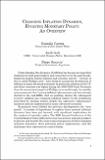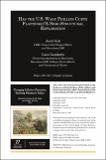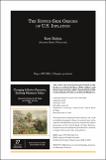Buscar
Mostrando ítems 21-29 de 29
Changing inflation dynamics, evolving monetary policy: an overview
Understanding the dynamics of inflation has become an important
challenge for both policymakers and researchers over the past decade.
Empirical models linking inflation and economic activity—versions of
the so-called Phillips curve—have failed to account for the behavior of
inflation in many ...
Has the U.S. wage phillips curve flattened? A semi-structural exploration
The deep and prolonged recession triggered by the global financial
crisis of 2007–2009 led to a large increase in the unemployment rate in
most advanced economies. Ten years later, at the time of writing this
paper, the recession has long ended, and the subsequent recoveries
have brought the ...
The supply-side origins of U.S. inflation
In recent years, we have not seen much of a negative correlation
between inflation, the time series plotted in figure 1, and measures of
resource slack, based on real GDP plotted in figure 2. This flattening
of the Phillips curve in many countries across the world has startled
monetary policymakers. ...
Comfort in floating: taking stock of twenty years of freely floating exchange rate in Chile
Chile offers an example of a country that has overcome the fear of floating by reducing balance-sheet mismatches; enhancing financial-market development; and improving monetary, fiscal, and political institutions; while strengthening policy credibility. Under the floating regime, Chile’s economic ...
Independence, credibility, and communication of central banking: an overview
The institution of central-bank independence is often lauded as a great conquest of the accumulation of knowledge and the sensible
setting of policy. The economic literature is filled with arguments for why an independent central bank would lead to better outcomes.
To this prior, the experience of ...
Central banking with many voices: the communications arms race
The job of central bankers is to use the monetary powers granted to them to promote price stability, sustainable growth, and a stable financial system. They do this in an environment fraught with unavoidable uncertainties. But, in conducting policy, there is one uncertainty that policymakers can and ...
Central banking with many voices: the communications arms race
Around the world, most central banks set policy by committee. This is motivated in part by the idea that groups reach better decisions than individuals and in part by a desire for representation of different geographical areas and economic constituencies in policymaking. The Bank for International ...
Risks to central-bank independence
Central banking today faces a number of existential challenges. On the political side, and particularly after the financial crisis, the public has come to expect central banks to take on a dizzying array of responsibilities, some far beyond their power or remit. These include everything from enhanced ...
Public trust and central banking
Central bank independence is one of the most remarkable pieces of institutional architecture fostered by economic thinking in the last half century. Theoretical studies in the 1980s stressed central bank independence as a precondition to bringing inflation under lasting control, and support for reform ...



